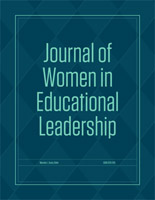Educational Administration, Department of

Journal of Women in Educational Leadership
Date of this Version
2007
Document Type
Article
Citation
Journal of Women in Educational Leadership, Vol. 5, No. 4--October 2007 ISSN: 1541-6224
Abstract
"You know, Hildegard, I didn't ask for this calling to support the cause of women." "Well I didn't ask for what happened to me either, Helen. Ijust happened to be born the tenth child of a wealthy family in the twelfth century. Do you know where the word "tithe" comes from? In my day, the 'tenth' child was 'donated'to the church. So stop whining and let's get on with this story." "Kind of cheeky for a 12th century nun, aren't you?" "We mystics can take on the vernacular of the time-should that be so surprising? In fact, one of my biographers correctly observed that there were 'limits to my patience and humility, and that 'meek' and 'ordinary' were the last words to describe me" (Flanagan, 1998, p. ix).
OK, so I occasionally talk with a brass statue of St. Hildegard of Bingen that I bought in Germany. Ironically, about eight years ago, an invitation to keynote at a German conference on women and educational leadership came out of the blue from someone who had heard me speak about the topic as a social justice issue. I did not know my host, or at least had never met her in the physical sense. A new initiative, "Gender Mainstreaming,H was beginning in Germany, which recently emerged from iron curtain rule. It was an intentional effort to increase the number of women in educational leadership positions. I spoke about encouraging and mentoring female leaders in education at the transatlantic conference. The leader of the initiative in Bavaria, the source of my invitation, was at the University of Augsburg. Her name is Hildegard ... I somehow felt compelled to buy the statue of her namesake while in a shop in that medieval city. I have felt Hildegard Bingen's presence ever since.


Comments
Copyright © 2007 Pro>Active Publications. Used by permission.